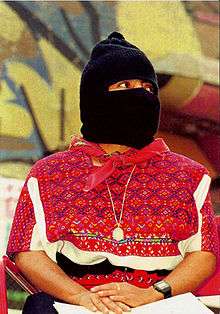Comandanta Ramona
| Comandanta Ramona | |
|---|---|
 | |
| Born |
1959 Chiapas, Mexico |
| Died | 2006 |
| Nationality | Mexican |
| Occupation | Revolutionary |
Comandanta Ramona (1959 – January 6, 2006) was the nom de guerre of an officer of the Zapatista Army of National Liberation (EZLN), a revolutionary indigenous autonomist organization based in the southern Mexican state of Chiapas. Perhaps the most famous female Zapatista actor, Ramona was one of seven female commanders in charge of directing an army that consisted of one-third women. A member of the Zapatista leading council, the CCRI (Clandestine Revolutionary Indigenous Committee), she served as a symbol of equality and dignity for indigenous and impoverished women.[1]
Biography
Ramona was born in 1959 in a Tzotzil Maya community in the highlands of Chiapas, Mexico.[2][3] Prior to joining the EZLN, Ramona earned a meager wage by selling artisan crafts. Tired of watching her impoverished community suffer, she joined the EZLN and became the voice of the many women who had been disregarded by the Mexican government for being seen as too small of a minority to influence public policy. This belief was later debunked after around 100,000 people turned out at the main square of Mexico's capital - proving that their presence in the country was big and that they were no longer going to endure laws that did not take their interests into account.[4]
Ramona took control of the city of San Cristóbal de las Casas, the former capital of Chiapas, during the January 1, 1994 Zapatista uprising. Ramona began a long fight with cancer the same year; in 1995, she received a kidney transplant,[5] which extended her life for over a decade.
In 1996, she broke through a government encirclement when she traveled to Mexico City to help found the National Indigenous Congress.[6] She was also the first Zapatista rebel to be granted government permission to travel outside of Chiapas for a three conference where she delivered the first of peace talks.[7] Ramona's peaceful demeanor and perseverance in her fight for the rights of her community turned her into an icon and symbol of equality.
Her last public appearance was at a preparation meeting—a plenary session for The Other Campaign—in Caracol de La Garrucha in the municipality of Francisco Gómez on September 16, 2005. After her death, Subcomandante Marcos suspended The Other Campaign activities for several days in order to be present at Ramona's funeral service.
Legacy
Ramona was famous for her petite body frame masked and clothed in indigenous dresses. Vendors in her home town created a doll version of Ramona which consisted of a masked peasant woman usually carrying a gun or a baby.[8]
See Also
References
- ↑ Zwarenstein, Carlyn (January 11, 2006). "Legacy of a Zapatista Rebel". The Globe and Mail. p. 19.
- ↑ Queen of the Neighbourhood Collective (2010). Revolutionary Women: A Book of Stencils. Oakland, California: PM Press. p. 99. ISBN 1604862009.
- ↑ Amozurrutia, Alina (2008). 101 Mujeres en la Historia de México (in Spanish). Mexico City: Grijalbo. p. 301. ISBN 9708103284.
- ↑ "Comandante Ramona". The Independent. Retrieved 2015-11-23.
- ↑ Davidson, Phil (January 11, 2006). "Comandanta Ramona; Zapatista Rebel Leader Dies". The Independent. p. 37.
- ↑ Ross, John (March 19, 1999). "The Zapatistas are Back". LA Weekly.
- ↑ http://www.lexisnexis.com/hottopics/lnacademic/?verb=sr&csi=8075
- ↑ Wolfwood, Terry (August 1997). "Who Is Comandanta Ramona?" (PDF). Third World Resurgence No. 84,. Retrieved November 20, 2015.